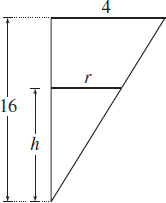EXAMPLE 3Constructing a Model from a Verbal Description
A liquid is poured into a container in the shape of a right circular cone with radius 4 meters and height 16 meters, as shown in Figure 33. Express the volume V of the liquid as a function of the height h of the liquid.
Solution The formula for the volume of a right circular cone of radius r and height h is V=13πr2h
The volume depends on two variables, r and h. To express V as a function of h only, we use the fact that a cross section of the cone and the liquid form two similar triangles. See Figure 34.
Corresponding sides of similar triangles are in proportion. Since the cone's radius is 4 meters and its height is 16 meters, we have rh=416=14r=14h
21
Similar triangles and geometry formulas are discussed in Appendix A.2, pp. A-13 to A-14.
Then V=13πr2h=↑13π(14h)2h=148πh3r=14h
So V=V(h)=148πh3 expresses the volume V as a function of the height of the liquid. Since h is measured in meters, V will be expressed in cubic meters.
